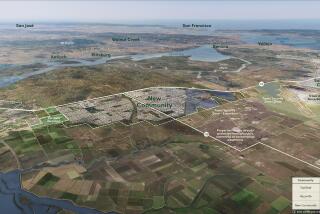Calabasas Wants Stars in Its Skies
The movement’s motto might be “Let there be dark.”
Calabasas has joined the growing number of communities worldwide that want skies illuminated by stars, not Klieg lights.
Limiting light pollution has long been a goal of the upscale community in the west San Fernando Valley, according to Mayor Lesley Devine.
The city is now hammering out a so-called dark skies ordinance that takes a common-sense approach to outdoor lighting, she said.
“ ‘Dark skies’ is simply the new buzz word for considerate lighting,” Devine said. “If a new house was built next to you and they had floodlights shining into your bedroom, you wouldn’t be happy. If they had low-level security lights that shone down on their own property, you wouldn’t care.”
The nearby community of Agoura Hills is also considering an ordinance, said Jeff Reinhardt, the city’s mayor pro-tem. The process there is just beginning, but many community members have expressed a desire for less light at night.
“We’re losing our stars and our view of the heavens,” said resident Pat MacGregor, 69. “I went out every night [last] week and tried to see the meteor shower, and I never could.”
Until recently, MacGregor lived in Old Agoura, a rural area that has barred streetlights to preserve its inky night skies.
“Just because we live in the city doesn’t mean we can’t have some of the benefits of living in the country,” MacGregor said. “It may sound trivial compared to other things, but every little bit we lose adds up.”
The movement to use less light has burgeoned since 1988, with the formation of the International Dark-Sky Assn.
Based in Tucson, the nonprofit group has about 9,500 members, including many astronomers who have long been aware that artificial light obscures the heavens. The organization advocates more intelligent outdoor lighting, including shielding streetlights and directing light--where needed--down, not up, where it does little more than illuminate the undersides of birds, as the group likes to point out.
In February, the Czech Republic instituted the first national law limiting light pollution. So many communities are adopting similar ordinances that the group has trouble keeping track of them, said technical manager Scott Davis.
New Mexico has a state law limiting artificial light, and eight Southern California communities have ordinances, including San Diego and Palm Desert, said Laverne Booth, an amateur astronomer with the association.
When celestial objects are visible, Booth said, “what you are seeing is a beautiful spectacle. But when you understand what you’re seeing, it becomes even more impressive. There’s a saying that backyard astronomy is the gateway to science education.”
In Calabasas, former mayor and current Councilwoman Janice Lee has been a forceful advocate for such measures as covering the tops of lights and using no-glare lighting.
“There seems to be a forgotten element to all our planning--what happens when the sun goes down,” Lee said.
She would like to see an ordinance that applies to residences, businesses and public buildings alike.
“I think one of our worst offenders is our city facilities,” she said, citing city tennis courts “lit up like alien landing zones.”
Last year, the city brought in a professional lighting consultant who specified preferred light levels in lumens, a standard unit of light measurement in science, and made other technical recommendations.
Some members of the council found the resultant document hard to understand, including Devine, who said her philosophy is, “If you can’t explain it to your grandmother or your 10-year-old, don’t vote for it.”
Devine said she wants to make sure the new ordinance does not put too great an economic burden on current residents.
“Unless it’s for health and safety, I don’t think it’s right to make existing residents retrofit at great expense,” she said. “New development is fair game.”
The city staff is now drafting a more accessible ordinance for the council to consider.
Once people come to think of light as a pollutant, they begin to see its downside. As Reinhardt pointed out, wildlife shares the land with humans in Agoura Hills and nearby communities, and inappropriate lighting can disrupt the animals.
Dark-sky advocates said mountain lions avoiding artificial light sometimes miss the crucial bridges that connect parts of their shrinking habitat.
And millions of migrating birds and billions of insects slam into lighted towers and other structures each year.
Security is often cited as a reason to keep on outdoor lights. But dark-sky proponents said higher light levels offer no guarantee.
Better technology such as motion detectors can improve security, they said, without wasting energy or obscuring the Milky Way.
More to Read
Sign up for Essential California
The most important California stories and recommendations in your inbox every morning.
You may occasionally receive promotional content from the Los Angeles Times.










